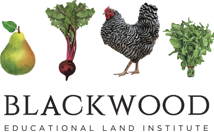 Blackwood Land has many locations perfect for an adult to work in, play in, and take in all of nature. But nature does not only need the love and respect of adults and neither, Blackwood figures, should they. This need for a space for children has led to the Children’s Garden, a space just for kids on the Land. Cath Conlon walks us through the purpose and future of the Children’s Garden:
Blackwood Land has many locations perfect for an adult to work in, play in, and take in all of nature. But nature does not only need the love and respect of adults and neither, Blackwood figures, should they. This need for a space for children has led to the Children’s Garden, a space just for kids on the Land. Cath Conlon walks us through the purpose and future of the Children’s Garden:
What is the Children’s Garden?
When you have adults and children in the same space, adults leave the space with organization and tidiness in their world. When kids come into that space, they see this organization and they learn from it what orderliness looks like. But when kids play around, it looks chaotic. It’s their sensibilities at that time in their life.
There’s a huge give and take between adults and children, and there’s a huge give and take in sharing a garden. The Children’s Garden is there so it can be chaotic in the way that it makes sense to kids at that time in their life.
From the Children’s Garden, we’re planting to actually grow and harvest to sell or use. When we have camps like Camp Little Feet, we want to be able to care for the families that are going to eat with us, and we want that food to be from the Children’s Garden, so we need a place for kids to feed themselves in.
Why did you start the garden?
Children need to play and a garden is just as big of a place to play as a playground. They need a place to experiment. They need to see the roots of the plants and pull the plant up just to try it. They need an opportunity to see how the world actually works. And they need their space to play.
We’ve taken play away from them. Kids grow up with a lot of rules—“stay off the grass,” or “don’t play in the dirt.” We want to bring play back to them.
We hope to begin to restore our farmers by starting at this very early age. Yes, a kid can learn when you start them at 10 years old, but think about the jump start if they began learning at 1 or 2 years old. They come at the work with such a sense of respect and integrity. That’s what we want to bring to our farming community.
What can children learn from the garden?
We want kids to know where their food comes from. Where does it come from before the grocery store? We also want to teach kids about soil sciences. Houston puts so many chemicals in the water to offset the bacteria that people put in from oil and trash, and all of that leads back to our drinking water.
Another thing we want to teach kids is to be active. When schools come here, teachers will specifically ask “Will you please teach our teachers and students some tools to take back to school and help us calm down and face stress.” Kids’ education can’t just be 100% book knowledge, nor 100% physical knowledge. It has to be 50-50 so the mind is feeding the body and the body is also feeding the mind.
What is a memorable moment that you’ve seen children experience in the garden?
Kids love digging in the dirt. We had sweet potatoes in there that we planted a year ago and you would have thought they were digging for the crown jewels. Whenever they found a sweet potato, you’d think they’d found gold! It was something that was very important to them.
Is the Garden open now?
Yes, lots of children have been in it. Adults have been in it, too. Right now, adults and children all share the same space, but we’re going to fence off an area just for kids.
What is the future goal for the Children’s Garden?
One of the things that I drew on for the garden was I kept hearing adults ask questions about what more they can do to help our environment. They feel like they’ve reached a wall. They’re already doing all the little things they can—not using plastic bags, taking their own bags for shopping, changing out light bulbs, having a compost pile—and they want to know what’s next.
If everybody’s doing all the little things, that makes a big thing. There’s not just one big thing that everyone can do. It’s everyone paying attention to those little things that make a difference.
Our goal is to be a model of that for little kids. Parents really purchase for their kids and if a kid says “Mom, you shouldn’t buy this product because look at all the packaging,” the parents will stop and think about it.
We want to be a model for what a household looks like, and how a household responds.
